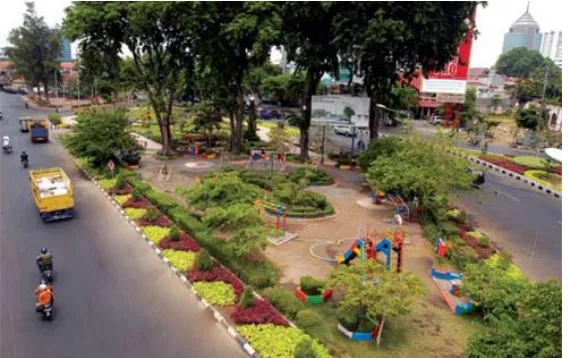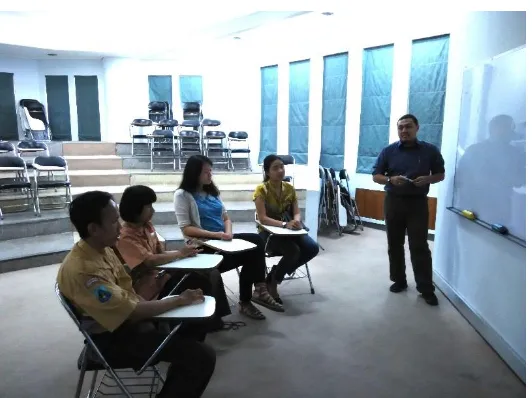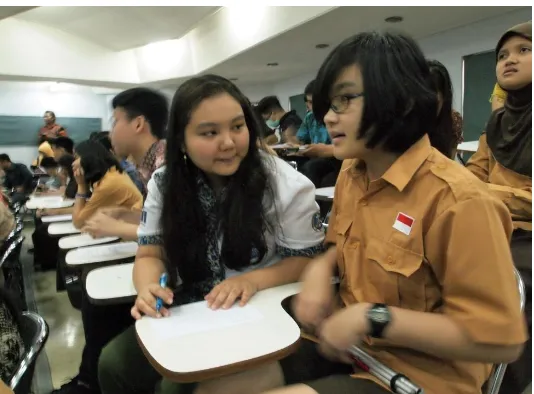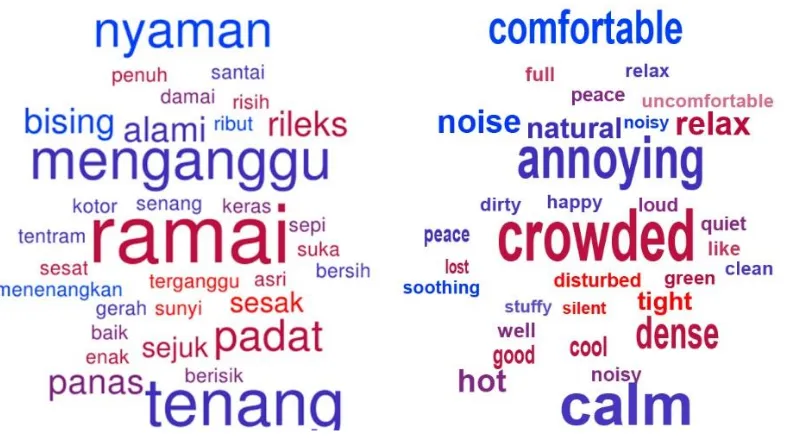An Initial Study of Soundscape of Visually Impaired People in
Urban Parks
1C.E. Mediastika, 2A.S. Sudarsono, 1L. Kristanto, 1G. Tanuwidjaja, 1R.G. Sunaryo, 1R. Damayanti
1 Department of Architecture, Petra Christian University, Surabaya, Indonesia
Email: [email protected]
2 Department of Physics Engineering, Bandung Institute of Technology, Bandung, Indonesia
Abstract
Urban parks in a developing country hardly accommodate people with disability. The objective
of this study is to investigate the possibility of improving urban parks using the perception of
visually impaired people of urban parks’ sonic environment. This study was conducted off-site
the urban park using a questionnaire survey with two groups of participants: sighted people (35
participants) and visually impaired people (35 participants). The analysis was conducted using
semantic analysis from the word used for explaining the sonic environment. This study shows
that the visually impaired participants explained the sonic environment with more terminology
(56 terminologies for visually impaired participants and 32 terminologies for sighted
participants). It indicates the engagement with the sonic environment is higher for the visually
impaired participants compared to the sighted participants. Further analysis using semantic
categorization also shows that the visually impaired participants have broader perception
compared to the sighted participants. The sighted participants use the terminology related to the
perception of comfort, dynamic of the sound source, and other perceptions (visual and thermal).
The visually impaired participant answers also represent the same aspect, but with more
perception: safety, directivity, and space.
1. Introduction
An urban park is ideally a place with relaxing atmosphere surrounded by fresh air and calming
environment. It is a place where rainwater is absorbed for water conservation. It is also a place
where urban communities may escape from the stressful urban activities, a place where the
natural soundscape is present. A study showed that people like to hear the natural soundscape
as it comforts and calms heart and mind (Yan and Kang, 2005). In Indonesia, urban population
grows rapidly and results in the excessive development of buildings and infrastructures to
accommodate the population needs. For movement, Indonesians are now assisted by the ease
of ownership of motorized vehicles, which increases the number of motorized vehicles
significantly. It directly triggers more noise in the surrounding area. In the end, it creates a
totally different urban soundscape compared to that of the earlier decades. The rapid turnover
causes a significant degradation of the built environment (Schulte-Fortkamp et al, 2006; Ge,
2009; Semidor, 2006).
A soundscape is a surrounding sound experienced by a person in a particular location. In the
early decades, the soundscape was a hi-fi (high fidelity) soundscape. It is when the background
sounds around us is at a low-pressure level so that people easily hear the type of sounds around
them. In the past, natural soundscape was dominant. Nowadays, the urban soundscape has
dramatically changed to lo-fi (low fidelity). In the lo-fi soundscape, the masking of sound is
very strong caused by a quite loud background noise. In the lo-fi soundscape, people are
difficult to recognize sounds, especially when machinery sounds are dominant. Dubois et al
(2006) described that people can tolerate the sound of people activities than machinery sound.
The unrecognizable urban soundscape caused by machinery sounds may create an
uncomfortable and unsafe environment for people. Visually impaired people may be positioned
as the most vulnerable here, due to the inability to see the surrounding. The lo-fi soundscape
This condition happens also in urban public areas such as urban parks, where all urban
communities gather for calming and soothing. Surabaya is a second metropolitan city in
Indonesia with better quality and more percentage of urban parks compared to other cities in
Indonesia. Surabaya’s urban parks have become a role model for other Indonesia cities. The
rapid development of urban parks in Surabaya started approximately the last 10 years when the
current mayor was the head of Cleanliness and Landscape Office Surabaya. From only one to
three parks, now it is more than 30 active urban parks in Surabaya. The rigorous development
of urban parks in Surabaya was highly appreciated by the communities. However, with so many
parks, the ideal condition of urban parks in Surabaya has not been fully perceived. Most urban
parks in Surabaya are located adjacent to major streets condensed with motorized vehicles with
the potentiality of traffic noise dispersion to the park area. It creates lo-fi soundscape within the
parks, where natural sounds are difficult to be perceived.
Sighted people commonly mark and enjoy the surrounding visually. It includes the way how
sighted people enjoy the urban parks. We mostly slide aside the need for a community with a
visual disability who use hearing sense to mark, locate and enjoy the environment. Apart from
the audio features that are barely experienced by the urban park visitors, safe and comfortable
access to the parks are also an issue of most Surabaya urban parks. There are parks where safe
access is unavailable, especially for those with disabilities. Taman Pelangi Surabaya, for
example, is surrounded by streets for U-turn. No bridge or underground pathways for
pedestrians to access the parks. Even a city park designed specifically for the elderly, namely
Taman Lansia is surrounded by major streets where there is no safe access for people to go into
(Figure 1 and Figure 2). The use of the soundscape of the visually impaired is interesting since
there was soundscape research, but none of them had particularly examined the soundscape of
visually impaired people, not even to utilize visually impaired person’s capability in
Coensel, et al, 2005; Dubois, et al, 2006; Evensen, et al, 2016; Lynch, et al, 2011; Miller, 2008;
Nilsson, et al, 2006; Raimbult and Dubois, 2005.
Figure 1. City map of two urban parks in Surabaya namely Taman Lansia (Senior Garden) and Taman Pelangi (Rainbow Garden) that are surrounded by major streets but without
appropriate access.
Figure 2. Bird’s eye view of Taman Persahabatan (Friendship Garden) surrounded by streets and insufficient access.
Concerning this condition, a project was programmed to invite visually impaired people to
participate in soundscape surveys both off-site and on-site (for the later stage). The project
focuses on Taman Bungkul, the most popular and most visited park in Surabaya. The
soundscape experienced by the visually impaired respondents will be utilized as a tool to map
the comfort and safety perception of visually impaired people toward an urban park. The desired
at the end of the project, a recommendation for more habitable urban parks may be borne-out;
i.e. a more habitable park for both sighted and visually impaired communities.
2. Methods
At the very first stage, the aim of the project was to collect people’s perception of an urban park
without necessarily being on-site. This stage was deliberately designed to be off-site to
investigate participants’ perception of the sonic environment that they have experienced before,
for those who already have a chance to visit a park; and to purely collect people’s imagination
or expectation of an urban park, for those who do not have a chance to visit a park. This stage
was conducted using both qualitative and quantitative methods. The qualitative was employed
in the first stage using focused group discussion of 2 sighted persons and 2 visually impaired
persons. The finding of the focused group discussion was then used as a reference to develop
questionnaires for the later quantitative stage. The questionnaire was developed simply in the
structure for the ease of the visually impaired to elaborate the question before answering. The
visually impaired participants answered the questionnaire assisted by sighted participants who
were also respondents in this project (Figure 5). There were two groups of respondents, i.e.
group of sighted people and group of visually impaired, and each consists of 35 persons, thus
70 respondents in total. All respondents are within school-age and college-age between 14 to
22 years old. Prior to the questionnaire survey, all respondents were examined of their hearing
ability, assuring that they normally perceive sound around them (Figure 3). The hearing test
Figure 3. Hearing test for both sighted participant (left) and visually impaired participant (right).
Figure 4. The first stage of the project was focused group discussion.
3. Finding and discussion
At the first stage, the focused group discussion was carried out to collect the general perception
of urban parks among participants consist of two visually impaired persons and two sighted
persons (Figure 4). The focused discussion was led by a question on what comes across the
participants’ mind when people talk about urban parks. They may describe the park in a word
or a sentence or even a paragraph. Both type of participants also expressed the reason for
prior or after visiting a park, i.e. shopping either for food or other daily needs. From the focused
group discussion, some terminologies were borne-out. At this stage, the visually impaired
described both “visual” and sonic environment of urban parks with more terminologies that the
sighted ones. The findings from the focused group discussion were to be strengthened by the
questionnaire stage.
Figure 5. The visually impaired participant (right) was assisted by the sighted participant (left) to describe their perception of urban parks off-site.
At the quantitative stage, the data collected from questionnaires were elaborated using word
clouds (Figure 6 and Figure 7). Word clouds were selected due to the capability to identify
Figure 6. The terminologies of sonic environment of urban parks by the visually impaired participants in Bahasa Indonesia (left) and in English (right).
Figure 7. The terminologies of sonic environment of urban parks by the sighted participants in Bahasa Indonesia (left) and in English (right).
By the word clouds, we may learn that visually impaired participants described the urban parks’
soundscape with more terminologies compared to the sighted ones (compare Figure 6 and
Figure 7). The visually impaired participants explained the sonic environment with 56
terminologies, whilst the sighted respondents explained it with 32 terminologies. It indicates
the engagement with the sonic environment is higher for the visually impaired participants
of the visually impaired relates to safety, directivity, and space, which are not borne- out from
the sighted participants. The terminologies that relate to safety are confused, afraid, dangerous,
safe, and worry (5 terminologies). The terminologies that relate to directivity are position,
important, near, directed, and confused (5 terminologies). The terminologies that relate to space
are oversized, opened, wide, too small, big, full, and few (7 terminologies). The terminology
“confused” may be plotted to the sonic environment of both safety and directivity. Interestingly,
there was also terminology of “contaminated” which seems not belong to either safety,
directivity, or space.
The nearly equal ratio of terminologies (5:5:7) of safety, space and directivity indicate that for
the visually impaired participants, the aspects of safety, space, and directivity in an urban park
are equally important. With the safety, space, and directivity aspects are 1/3 of the total
terminologies perceived by the visually impaired participants, we ideally consider these aspects
while improving urban park facilities.
4. Conclusion and Recommendation
The initial study of the soundscape of visually impaired shown that visually impaired person
perceived the sonic environment more detail than the sighted person. They perceived sound
surround them as a guide to their activities. It indicates and strengthens the finding of the earlier
research that sighted people perceived their surroundings more visually rather than auditory
(Nilsson et al., 2012 and Jeon et al., 2012). It is an indication that safety, space, and directivity
are all similarly important aspects of an urban park for the visually impaired to explore and
enjoy the park. Further research to explore the visually impaired person’s perception of an on
-site survey is recommended to obtain more data for detailed design recommendation for urban
Acknowledgment
The research team would like to express sincere gratitude to the United Board for Christian
Higher Education in Asia for providing full funding to conduct this research. Gratitude was
also sent to YPAB Surabaya for participating in the survey.
References
Botteldooren, D, De Coensel, B. and De Meur, T. (2006). The temporal structure of urban
soundscape, J. of Sound and Vibration, 292 (1): 105-123.
Cowan, J.P. (1994). Handbook of environmental acoustics, New York: Van Nostrand Reinhold.
De Coensel, B, De Meur, T. and Botteldooren, D. (2005). The influence of traffic flow
dynamics on urban soundscapes. Applied Acoustics, 66 (2): 175-194.
Dubois, D., Guastavino, C., Raimbault, M. (2006). A cognitive approach to urban soundscapes:
using verbal data to access everyday life auditory categories. Acta Acustica united with
Acustica, 92(6):865-874.
Evensen, K.H., Raanaas, R.K., Fyhri, A. (2016). Soundscape and perceived suitability for
recreation in an urban designated quiet zone, Urban Forestry and Urban Greening, 20:
243-248.
Ge, J., Lu, J., Morotomi, K., Hokao, K. (2009). Developing soundscapegraphy for the notation
of urban soundscape: its concept, method, analysis and application, Acta Acustica
united with Acustica, 95(1): 65-75.
Gonzales-Mora, J.L. (2006). Engineering Applications of Bio-Inspired Artificial Neural
Networks.
Volume 1607 of the series lecture notes in computer science pp 321-330, Date: 17 November.
Jeon, J.Y., Lee, P.J., You, J., Kang, J. (2012). Acoustical characteristics of water sounds for
soundscape enhancement in urban open spaces. The Journal of the Acoustical Society
Lynch, E., Damon, J., and Kurt, F. (2011). An assessment of noise audibility and sound levels
in US national parks, Landscape Ecology, 26:1297.
Miller, N.P. (2008). US national parks and management of park soundscapes: a review, Applied
Acoustics, 69(2): 77-92.
Nilsson, M.E. & Berglund, B. (2006). Soundscape quality in suburban green areas and city
parks, Acta Acustica united with Acustica, 92(6): 903-911.
Nilsson, M.E., Jeon, J.Y, Rådsten-Ekman, M., Axelsson, O., Hong, J.Y., Jang, H.S. (2012). A
soundwalk study on the relationship between soundscape and overall quality of urban
outdoor places. The Journal of the Acoustical Society of America, 131(4): 3474.
Schafer, R.M. (1977), The tuning of the world: toward a theory of soundscape design, 2nd
edition, published as Our sonic environment and the tuning of the world. New York:
Alfred A-Knopf.
Schulte-Fortkamp, B. & Fiebig, A. (2006). Soundscape analysis in a residential area: an
evaluation of noise and people's mind, Acta Acustica united with Acustica, 92(6):
875-880.
Semidor, C. (2006). Listening to a city with the soundwalk method, Acta Acustica united with
Acustica, 92(6): 959-964
Raimbult, M. & Dubois, D. (2005). Urban soundscapes: experiences and knowledge. Cities, 22
(5): 339-350.
Wrightson, K. (2000). An introduction to acoustic ecology, accessed from
http://www.econtact.ca/5_3/wrightson_acousticecology.html on May 15, 2016
Yang, W. & Kang, J. (2005). Soundscape and sound preferences in urban squares: a case study



